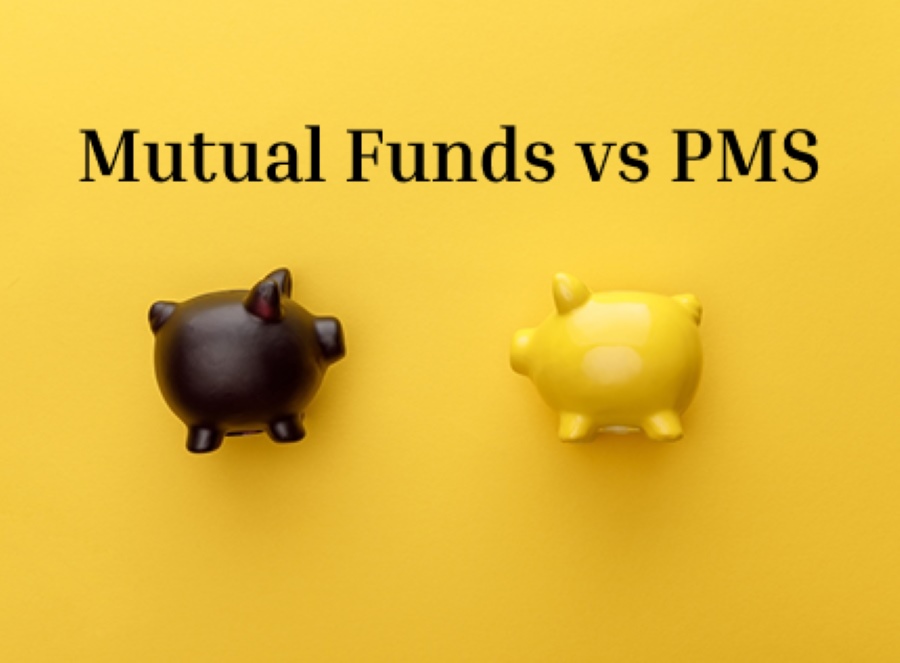Simplifying Life Insurance in India
Difference Between Mutual Fund vs PMS

Every investor wants to grow wealth, but finding the best smart investing path can be hard. Mutual Fund and Portfolio Management Services (PMS) are two of the most powerful options. You typically choose Mutual Funds for affordability and diversification, while PMS allows for more personal strategies and greater control, usually for large portfolios.
The choice you make depends on your capital allocation priorities, risk tolerance, and level of participation. This article outlines key points to consider so you can confidently make an informed choice between mutual funds and PMS.

Table of Contents

What is a Mutual Fund?
A mutual fund is an investment vehicle that pools money from multiple investors to create a diversified portfolio of stocks, bonds, government securities, or even gold. The money in a mutual fund is actively managed by a professional fund manager who makes decisions on behalf of the fund.
Mutual funds are suitable for novice and experienced investors who want exposure to the financial markets without the rigour of managing individual assets directly.
What is Portfolio Management Services (PMS)?
Portfolio Management Services (PMS) are customised investment services specifically designed for high-net-worth clients who seek tailored portfolio management. PMS allows for individualised investment management while providing benefits above mutual funds, such as direct ownership of securities.
Like mutual funds, PMS can consist of equities, fixed income, structured products, or a combination. It offers personalised investment strategies tailored to investors' risk tolerance and financial goals.
Key Difference Between PMS and Mutual Funds
Investors often evaluate Portfolio Management Services (PMS) and Mutual Funds (MFs) to see which would appropriately match their financial objectives, risk appetite, and investment style. While both provide exposure to one or more asset classes and are managed professionally, they are fundamentally different. Below is a summary of the key differences:
Types of Portfolio Management Services (PMS)
PMS can be classified by the type of control exercised, PMS management style, and the portfolio manager's and client's level of involvement. The following are the main types of PMS:
Types of Mutual Funds
Mutual funds are classified within an asset class, investment objective, and structure. Each type is provided to serve different investor needs and risk appetites. The major types of funds are as follows:
Factors to Consider Before Investing in PMS and Mutual Funds
When deciding between PMS and mutual funds, looking closely at financial objectives, risk appetite, and other operational characteristics is necessary. Below are the key factors that allow users to make a well-informed decision:
Which is Better Between PMS and a Mutual Fund?
Whether you want PMS or mutual funds depends on your financial goals, risk tolerance, and investment objectives.
- PMS is appropriate for high-net-worth individuals (HNIs) with ₹50 lakh or more to invest. PMS has concentrated stock exposure and investment flexibility, but typically also maintenance fees and lower liquidity. Thus, PMS is best for long-horizon investors willing to take significant risks when investment markets recover.
- On the other hand, Mutual Funds are generally available to retail investors from ₹100-₹500 for a monthly or one-time investment. In turn, you'll have exposure to a large pool of diversified mutual funds across 40- 50+ securities as part of that mutual fund. Mutual funds are an easy, low-cost way to build wealth with good liquidity.
- Hence, you should select PMS if you are an HNI who wants those large, custom, high-risk clients and is prepared to pay that maintenance fee. Select Mutual Funds if you are a retail investor who simply wants cost efficiency and simplicity, and wants to invest/accumulate wealth passively over time.
Choosing between PMS and mutual funds is not about which is better. It's about determining which investment vehicle aligns more closely with an investor's financial objectives, risk profile, and desire for involvement. Before making an investment decision, it is prudent to refresh your financial roadmap.
Do you prefer a high-involvement, tailored portfolio, or do you prefer to have a diversified fund with a professional manager? Your answer may define the options available to you.
Disclaimer: The information provided on this website is for general informational purposes only and should not be construed as financial, investment, or legal advice. While we strive to provide accurate and up-to-date content, we do not guarantee the completeness, reliability, or suitability of the information for your specific needs.
We do not promote or endorse any financial product or service mentioned in these articles. Readers are advised to conduct their own research, consult with financial experts, and make informed decisions based on their unique financial circumstances. Any reliance you place on the information provided here is strictly at your own risk.
FAQs about Mutual Funds vs PMS
What is the primary difference between PMS and mutual funds?
Who should consider investing in PMS over mutual funds?
What is the minimum investment required for PMS and mutual funds?
How does portfolio customisation differ between PMS and mutual funds?
Are PMS returns always higher than mutual funds?
How do the fee structures of PMS and mutual funds compare?
Which is riskier: PMS or mutual funds?
How does transparency differ between PMS and mutual funds?
What is the liquidity implication of PMS and mutual funds?
How are taxes applied to PMS and mutual funds?
Can PMS and mutual funds invest in the same stocks?
Do PMS and mutual funds have different regulatory frameworks?
How does the investment process differ between PMS and mutual funds?
Which offers better diversification: PMS or mutual funds?
Are PMS portfolios more flexible than mutual funds in asset allocation?
What is the ownership structure in PMS vs mutual funds?
Which is better for long-term wealth creation: PMS or mutual funds?
What are the disadvantages of mutual funds over PMS?
Other Important Articles about Mutual Funds
Latest News
Read More




















